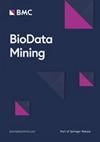Machine-learning-based models to predict cardiovascular risk using oculomics and clinic variables in KNHANES
IF 6.1
3区 生物学
Q1 MATHEMATICAL & COMPUTATIONAL BIOLOGY
引用次数: 0
Abstract
Recent researches have found a strong correlation between the triglyceride-glucose (TyG) index or the atherogenic index of plasma (AIP) and cardiovascular disease (CVD) risk. However, there is a lack of research on non-invasive and rapid prediction of cardiovascular risk. We aimed to develop and validate a machine-learning model for predicting cardiovascular risk based on variables encompassing clinical questionnaires and oculomics. We collected data from the Korean National Health and Nutrition Examination Survey (KNHANES). The training dataset (80% from the year 2008 to 2011 KNHANES) was used for machine learning model development, with internal validation using the remaining 20%. An external validation dataset from the year 2012 assessed the model’s predictive capacity for TyG-index or AIP in new cases. We included 32122 participants in the final dataset. Machine learning models used 25 algorithms were trained on oculomics measurements and clinical questionnaires to predict the range of TyG-index and AIP. The area under the receiver operating characteristic curve (AUC), accuracy, precision, recall, and F1 score were used to evaluate the performance of our machine learning models. Based on large-scale cohort studies, we determined TyG-index cut-off points at 8.0, 8.75 (upper one-third values), 8.93 (upper one-fourth values), and AIP cut-offs at 0.318, 0.34. Values surpassing these thresholds indicated elevated cardiovascular risk. The best-performing algorithm revealed TyG-index cut-offs at 8.0, 8.75, and 8.93 with internal validation AUCs of 0.812, 0.873, and 0.911, respectively. External validation AUCs were 0.809, 0.863, and 0.901. For AIP at 0.34, internal and external validation achieved similar AUCs of 0.849 and 0.842. Slightly lower performance was seen for the 0.318 cut-off, with AUCs of 0.844 and 0.836. Significant gender-based variations were noted for TyG-index at 8 (male AUC=0.832, female AUC=0.790) and 8.75 (male AUC=0.874, female AUC=0.862) and AIP at 0.318 (male AUC=0.853, female AUC=0.825) and 0.34 (male AUC=0.858, female AUC=0.831). Gender similarity in AUC (male AUC=0.907 versus female AUC=0.906) was observed only when the TyG-index cut-off point equals 8.93. We have established a simple and effective non-invasive machine learning model that has good clinical value for predicting cardiovascular risk in the general population.基于机器学习的模型,利用 KNHANES 中的眼动学和临床变量预测心血管风险
最近的研究发现,甘油三酯-葡萄糖(TyG)指数或血浆致动脉粥样硬化指数(AIP)与心血管疾病(CVD)风险之间存在密切联系。然而,目前还缺乏对心血管风险进行无创、快速预测的研究。我们的目的是开发并验证一种基于临床问卷和眼科变量的机器学习模型,用于预测心血管风险。我们从韩国国民健康与营养调查(KNHANES)中收集了数据。训练数据集(80%来自2008年至2011年的KNHANES)用于机器学习模型的开发,其余20%用于内部验证。2012年的外部验证数据集评估了模型对新病例中TyG指数或AIP的预测能力。我们在最终数据集中纳入了 32122 名参与者。机器学习模型使用 25 种算法,通过眼科测量和临床问卷进行训练,以预测 TyG 指数和 AIP 的范围。接受者操作特征曲线下面积(AUC)、准确度、精确度、召回率和 F1 分数用于评估机器学习模型的性能。根据大规模队列研究,我们将 TyG 指数临界点定为 8.0、8.75(上三分之一值)、8.93(上四分之一值),将 AIP 临界点定为 0.318、0.34。超过这些临界值表明心血管风险升高。表现最好的算法显示 TyG 指数临界值为 8.0、8.75 和 8.93,内部验证 AUC 分别为 0.812、0.873 和 0.911。外部验证的 AUC 分别为 0.809、0.863 和 0.901。对于 0.34 的 AIP,内部和外部验证的 AUC 相似,分别为 0.849 和 0.842。在 0.318 临界值时,AUC 分别为 0.844 和 0.836,表现略低。TyG指数在8(男性AUC=0.832,女性AUC=0.790)和8.75(男性AUC=0.874,女性AUC=0.862)以及AIP指数在0.318(男性AUC=0.853,女性AUC=0.825)和0.34(男性AUC=0.858,女性AUC=0.831)时有显著的性别差异。只有当 TyG 指数临界点等于 8.93 时,才能观察到 AUC 的性别相似性(男性 AUC=0.907 对女性 AUC=0.906)。我们建立了一个简单有效的无创机器学习模型,该模型对预测普通人群的心血管风险具有良好的临床价值。
本文章由计算机程序翻译,如有差异,请以英文原文为准。
求助全文
约1分钟内获得全文
求助全文
来源期刊

Biodata Mining
MATHEMATICAL & COMPUTATIONAL BIOLOGY-
CiteScore
7.90
自引率
0.00%
发文量
28
审稿时长
23 weeks
期刊介绍:
BioData Mining is an open access, open peer-reviewed journal encompassing research on all aspects of data mining applied to high-dimensional biological and biomedical data, focusing on computational aspects of knowledge discovery from large-scale genetic, transcriptomic, genomic, proteomic, and metabolomic data.
Topical areas include, but are not limited to:
-Development, evaluation, and application of novel data mining and machine learning algorithms.
-Adaptation, evaluation, and application of traditional data mining and machine learning algorithms.
-Open-source software for the application of data mining and machine learning algorithms.
-Design, development and integration of databases, software and web services for the storage, management, retrieval, and analysis of data from large scale studies.
-Pre-processing, post-processing, modeling, and interpretation of data mining and machine learning results for biological interpretation and knowledge discovery.
 求助内容:
求助内容: 应助结果提醒方式:
应助结果提醒方式:


